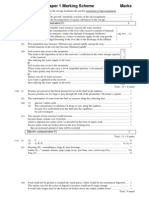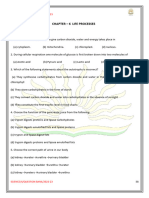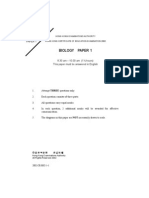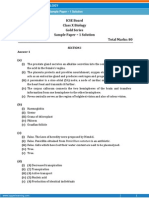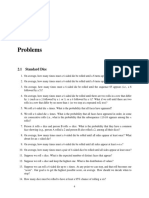HKCEE Paper I Running Answer Text 2000 Biology
HKCEE Paper I Running Answer Text 2000 Biology
Uploaded by
Kathy WongCopyright:
Available Formats
HKCEE Paper I Running Answer Text 2000 Biology
HKCEE Paper I Running Answer Text 2000 Biology
Uploaded by
Kathy WongOriginal Title
Copyright
Available Formats
Share this document
Did you find this document useful?
Is this content inappropriate?
Copyright:
Available Formats
HKCEE Paper I Running Answer Text 2000 Biology
HKCEE Paper I Running Answer Text 2000 Biology
Uploaded by
Kathy WongCopyright:
Available Formats
HKCEE Paper I running answer text 2000 Biology
1.
(a)(i) (a)(ii)
(a)(iii) (a)(iv) (a)(v)
The cells of A and the cells of the foetus are formed by mitosis of the zygote (1) female (2) A sperm carrying an X chromosome fused with an egg, which always contains an X chromosome to form a zygote with two X chromosomes, thus resulting in a female foetus. There are 3 chromosomes 21. The foetus may be expelled out of the uterus. Blood from A to the foetus has higher oxygen content and higher nutrient content, but lower carbon dioxide and urea content. Tissue A is *palisade mesophyll Tissue B is *spongy mesophyll Number of chloroplasts in region 1 is 20; while that in region 2 is 12. Ratio of chloroplast density in region 1 to that in region 2 is 5:3. This allows the leaf to carry out photosynthesis at a higher rate since tissue A has a higher density of chloroplasts and is located in the upper layer of the leaf, so its cells can receive more sunlight than the cells of tissue B. First put the stem of a leafy shoot in a dye solution for some time. Then cut cross sections of the stem and the leaf. Examine the sections under the microscope. If cell type C is responsible for the transport of water from the stem to the leaf, it would be stained by the dye. Oxygen in the tidal air first diffuses through the residual air and dissolves in the water film lining the air sac. Then it diffuses across the walls of the air sac and the capillary into the blood. (1) The volume of tidal air will increase (2) The oxygen uptake in the blood becomes faster because the distance of diffusion of oxygen from the tidal air to the water film is reduced. Or because the surface area of the air sac for diffusion of oxygen is increased. Particles deposit on the wall of the air sac thus reduces the rate of diffusion of oxygen.
1.
(b)(i) (b)(ii) (b)(iii)
(b)(iv)
1.
(c)(i)
(c)(ii)
(c)(iii)
2000-CE-BIO I-1
HKCEE Paper I running answer text 2000 Biology
2.
(a)(i)
(a)(ii) (a)(iii) (a)(iv)
The daily energy intake of Jane is 6620 kJ which is less than her daily energy requirement. Thus she has to consume the food reserve in her body, leading to a loss in her body weight. Amino acids are broken down in the liver to form carbohydrate. This will be used in respiration to release energy. anaemia Rub a piece of ham on a filter paper. If it contains fat, a translucent spot will remain after drying. Immerse the paper in an organic solvent and the spot will disappear. OR Add alcohol to a piece of ham and obtain a clear solution. Add water to the clear solution. The solution will turn milky if fat is present. From 1 to 5 units of light intensity, the size of the pupil decreases with increasing light intensity. However, when the light intensity is above 5 units, the size of the pupil will remain unchanged with increasing light intensity. This response helps to prevent excessive light from entering the eye, so that the light-sensitive cells of the retina would not be damaged. light-sensitive cells / photoreceptors sensory neurone / optic nerve association neurone in brain motor neurone / nerve iris muscle (Arrow signs should be included) Because all the light entering the eye is absorbed by the retina and the choroids, as a result no light is reflected out of the eye through the pupil.
2.
(b)(i)
(b)(ii) (b)(iii)
(b)(iv)
2000-CE-BIO I-2
HKCEE Paper I running answer text 2000 Biology
2.
(c)(i)
(c)(ii)
(c)(iii)
Advantage: The chance of pollination / fertilization is higher ) Less wastage of pollen grains ) any one Desirable characters of the parent are more likely to be transmitted) to the offspring ) Disadvantage: Less genetic variation (accept other correct answers) First remove the anthers from the flower before they are mature. Then use a brush to dust pollen grains of another pea flower onto the stigma of this flower. Finally cover the flower with a plastic bag to prevent further pollination. (1) Green pod colour is dominant to yellow pod colour or The allele for green pod colour is dominant to the allele for yellow pod colour (2) Let G represent the allele for green pods and g represent the allele for yellow pods F1 Gamete G Gg X Gg
F2
GG
Gg
Gg
gg
green pod yellow pod (The labels of F1, gamete and F2 should be included)
2000-CE-BIO I-3
HKCEE Paper I running answer text 2000 Biology
3.
(a)(i)
(a)(ii)
(a)(iii)
Blood capillary Its wall is one-cell thick / the diameter of the lumen is slightly greater than or similar to that of a red blood cell The pressure of blood in A is higher than the pressure of the fluid surrounding the muscle cells. This pressure difference forces the plasma except plasma proteins out of A. Drawing (D): clear and accurate diagram, double line for capillary wall, biconcave RBC Labels (L) : any three of the following labels and title
(1) (2)
A section along line BC (a)(iv) (small intestine) hepatic portal vein liver hepatic vein vena cava heart pulmonary artery (lung) (Arrow signs should be included) Diabetes is caused by the absence of certain substance(s) which can be found in the pancreas. To determine whether the substance in the pancreas extract effective in treating diabetes is a protein or a fat. Symptoms of diabetes would remain. This is because protease in the alimentary canal will digest the active substance which is protein in nature. In the diabetic person, the pancreas cannot produce enough insulin. Thus the liver cannot convert excess glucose in the blood into glycogen. Consequently, his blood glucose concentration remains high, leading to a high level of glucose in the glomerular filtrate. The kidney tubules cannot reabsorb all the glucose from the filtrate, thus glucose is excreted in the urine.
3.
(b)(i) (b)(ii) (b)(iii)
(b)(iv)
2000-CE-BIO I-4
HKCEE Paper I running answer text 2000 Biology
3.
(c)(i)
(c)(ii) (c)(iii)
The water potential of the cell sap of cell A is greater than that of the sucrose solution. Hence water moves out of the cell by osmosis. As a result, the vacuole shrinks in size and so pulls the cytoplasm away from the cell wall. The water potential of the cell sap of cell B may be the same or lower than that of the surrounding solution. (1) Adjust the position of the slide until cell A is at the centre of the field of vision. (2) Adjust the diaphragm / condenser to increase the illumination of the slide. Turn the adjustment knob until the cell is in focus.
2000-CE-BIO I-5
HKCEE Paper I running answer text 2000 Biology
4.
(a)(i) (a)(ii) (a)(iii)
(a)(iv) (a)(v)
The amylase converts starch into maltose To ensure that sufficient amount of maltose is produced When the temperature increases from 0-70oC, the amylase activity increases. When the temperature increases from 70-90oC, the amylase activity decreases. The optimum temperature for the activity of barley amylase is 70oC. Keep the mixture at very low temperature (below 10oC). The amylase is inactive but not denatured at such temperature. Incubate the mixture at a given temperature for a fixed period of time and then perform the Benedicts test. Measure the amount of red precipitate formed. High concentration of suspended solids reduces the light intensity in water. Thus the rate of photosynthesis of the producers decreases and this leads to a drop in the population of the producers. (2) Site D (1) The greater the amount of organic pollutants in water, the higher the bacterial population, because the organic pollutants provide food for the growth of bacteria. (2) Site C (3) Slow water current in the harbour ) There is sewage outfall at this site ) any one Large human population ) To protect endangered species (Accept other correct answers) When performing heavy exercise, rate of sweat production was faster. This was because large amount of heat was generated by the body during exercise. The body temperature started to increase and this stimulated the increase in sweat production. When the person is performing exercise, a large amount of water in the body was lost in the form of sweat, leading to a lowering of the water potential of the blood. Thus a greater proportion of water was reabsorbed from the glomerular filtrate, and hence less urine was produced. (1) The lining of the air sacs or respiratory tract is covered with a water film. Water in the water film evaporates into the air of the air sac and is lost during exhalation. (2) This is because the rate and depth of breathing was increased, so greater amount of air was exhaled from the lungs per unit time, leading to an increased rate of water loss through exhalation. (1)
4.
(b)(i)
(b)(ii)
(b)(iii)
4.
(c)(i)
(c)(ii)
(c)(iii)
2000-CE-BIO I-6
You might also like
- HKDSE Chemistry A Modern View (Book 1) AnswersDocument58 pagesHKDSE Chemistry A Modern View (Book 1) AnswersMatthew Chu57% (7)
- CPL Flight Planning ManualDocument94 pagesCPL Flight Planning ManualChina LalaukhadkaNo ratings yet
- Unit 2 Progress Check: MCQ: Ap Biology Scoring GuideDocument21 pagesUnit 2 Progress Check: MCQ: Ap Biology Scoring Guideghalia massoudNo ratings yet
- Respiration in Humans: Test Yourself 10.1 (Page 197)Document4 pagesRespiration in Humans: Test Yourself 10.1 (Page 197)lee67% (3)
- Algebraic Manipulation Worksheet 1Document3 pagesAlgebraic Manipulation Worksheet 1dreamydamsel100% (1)
- 2002 Biology Paper I Marking SchemeDocument8 pages2002 Biology Paper I Marking SchemetramysssNo ratings yet
- Chapter 8 AnswerDocument18 pagesChapter 8 AnswerKathy Wong0% (1)
- Chapter 4 AnswerDocument16 pagesChapter 4 AnswerKathy Wong100% (1)
- Book3 AnsDocument62 pagesBook3 AnsKathy Wong50% (2)
- 2001 Biology Paper I Marking SchemeDocument4 pages2001 Biology Paper I Marking Schemetramysss100% (2)
- HKCEE Paper I Running Answer Text 2002 BiologyDocument5 pagesHKCEE Paper I Running Answer Text 2002 BiologyKathy WongNo ratings yet
- HKCEE Paper I Running Answer Text 2001 BiologyDocument7 pagesHKCEE Paper I Running Answer Text 2001 BiologyKathy WongNo ratings yet
- HKCEE - Biology - 1999 - Paper I - A PDFDocument4 pagesHKCEE - Biology - 1999 - Paper I - A PDFChinlam210No ratings yet
- Hkcee Ans 2000Document9 pagesHkcee Ans 2000HONPUIYINo ratings yet
- HKCEE - Biology - 1998 - Paper I - A PDFDocument7 pagesHKCEE - Biology - 1998 - Paper I - A PDFChinlam210No ratings yet
- UACE BIOLOGY PAPER 1 2000 Marking GuideDocument5 pagesUACE BIOLOGY PAPER 1 2000 Marking GuideSsenono AndrewNo ratings yet
- Mentors Life Process Discussion PaperDocument7 pagesMentors Life Process Discussion Paperjsk.141197No ratings yet
- CircularDocument18 pagesCircularsamiksharajeshkannan2009No ratings yet
- Life Processes-Question BankDocument9 pagesLife Processes-Question Bankkfjg47zq26No ratings yet
- RW - Mcq-Ar-Case Study G10Document5 pagesRW - Mcq-Ar-Case Study G10akbarshahzinNo ratings yet
- HKCEE - Biology - 1997 - Paper I - ADocument8 pagesHKCEE - Biology - 1997 - Paper I - ALeroy ChengNo ratings yet
- International Biology Olympiad - Hong Kong Contest 2018 - 2018Document70 pagesInternational Biology Olympiad - Hong Kong Contest 2018 - 2018Ngọc CaiNo ratings yet
- Science Class X Chapter 05 Life Processes Practice Paper 02 2024 AnswersDocument8 pagesScience Class X Chapter 05 Life Processes Practice Paper 02 2024 Answersdarshbatra.inNo ratings yet
- Association of Teachers in Biological Sciences: National Standard Examination in Biology 2012-2013Document17 pagesAssociation of Teachers in Biological Sciences: National Standard Examination in Biology 2012-2013Mrinal Chaudhary100% (1)
- Biology F4 August 2024Document5 pagesBiology F4 August 2024gemstonesplanNo ratings yet
- Study Pad (AutoRecovered)Document7 pagesStudy Pad (AutoRecovered)asachomba25No ratings yet
- SELINA Paper Set 1 - 80 Mks - Anskey1Document5 pagesSELINA Paper Set 1 - 80 Mks - Anskey1ManviNo ratings yet
- Life ProcessesDocument7 pagesLife Processestasmitha98No ratings yet
- S4 Suggested Solution: 2015 - 2016 Secondary 4 Final ExaminationDocument5 pagesS4 Suggested Solution: 2015 - 2016 Secondary 4 Final ExaminationMa Hau YiNo ratings yet
- 2000-11 & 2012 Hkcee + Al LQDocument180 pages2000-11 & 2012 Hkcee + Al LQArthur ChoiNo ratings yet
- Life Processes 5 May 2024Document8 pagesLife Processes 5 May 2024AnamNo ratings yet
- Bio Ans 29 May 2023Document2 pagesBio Ans 29 May 2023waikokpoh007No ratings yet
- Multi-Choice Questions: Chapter 1: Production and GrowthDocument15 pagesMulti-Choice Questions: Chapter 1: Production and GrowthADrian ZeeGreatNo ratings yet
- IG1 Final Terminal Paper 2021Document20 pagesIG1 Final Terminal Paper 2021shahmir hassanNo ratings yet
- Biology: James Ruse Agricultural High SchoolDocument17 pagesBiology: James Ruse Agricultural High SchoolAlexCuiNo ratings yet
- Biology WorksheetDocument4 pagesBiology WorksheetAmmar RizwanNo ratings yet
- Biology Worksheet PDFDocument4 pagesBiology Worksheet PDFAmmar RizwanNo ratings yet
- NCSE 2007 SolutionsDocument5 pagesNCSE 2007 SolutionsShevica BlairNo ratings yet
- Vumbi Marking Guide of Biology A Level Carrefour Umurezi 2023-2024-1Document6 pagesVumbi Marking Guide of Biology A Level Carrefour Umurezi 2023-2024-1Theogene NTEGEREJIMANANo ratings yet
- 2002 Biology Paper1Document19 pages2002 Biology Paper1api-3822784No ratings yet
- Gr.10 Biology June Q.bankDocument18 pagesGr.10 Biology June Q.bankbhaavaneshrajukishoreNo ratings yet
- Biology (E) 2024Document48 pagesBiology (E) 2024Gowtham Reddy100% (1)
- CBQs BIOLOGY 10Document7 pagesCBQs BIOLOGY 10gdev5242No ratings yet
- ICSE-Biology Sample Paper-1-SOLUTION-Class 10 Question PaperDocument8 pagesICSE-Biology Sample Paper-1-SOLUTION-Class 10 Question PaperFirdosh KhanNo ratings yet
- Part-C BiologyDocument40 pagesPart-C Biologypriyajd2104No ratings yet
- Set CDocument5 pagesSet CHarsh PandeyNo ratings yet
- KJM S2 Bio PP2 MSDocument6 pagesKJM S2 Bio PP2 MS25850338naomiNo ratings yet
- Gr10 - Bio - PB1 AK 2024-Sample2Document7 pagesGr10 - Bio - PB1 AK 2024-Sample2Inaaya KhanNo ratings yet
- Biology Paper 2: 2001-CE BIODocument23 pagesBiology Paper 2: 2001-CE BIOMan wai KanNo ratings yet
- SG 20201A 6411d2a26b19d9.6411d2a5653567.36389693Document35 pagesSG 20201A 6411d2a26b19d9.6411d2a5653567.36389693Isaac LeeNo ratings yet
- WorksheetDocument3 pagesWorksheetanabanaNo ratings yet
- Respriation Competency BasedDocument8 pagesRespriation Competency BasedramanchalotraNo ratings yet
- Bio P1 MSDocument13 pagesBio P1 MSsmall.messhNo ratings yet
- 3 (7 Science 07-07-2024)Document3 pages3 (7 Science 07-07-2024)Desert GamingNo ratings yet
- Class X CH-6 WS Answer KeyDocument6 pagesClass X CH-6 WS Answer KeyYASHVI MODINo ratings yet
- Biology 9701 On23 P41Document19 pagesBiology 9701 On23 P412190ibrahimazeemNo ratings yet
- Marking Scheme Biology 2004 Paper 1 Marking SchemeDocument4 pagesMarking Scheme Biology 2004 Paper 1 Marking Schemeapi-381289475% (4)
- O Level Biology Practice Questions And Answers Transport In PlantsFrom EverandO Level Biology Practice Questions And Answers Transport In PlantsNo ratings yet
- O Level Biology Practice Questions And Answers: Ecology And Our Impact On The EcosystemFrom EverandO Level Biology Practice Questions And Answers: Ecology And Our Impact On The EcosystemNo ratings yet
- O Level Biology Practice Questions And Answers Plant NutritionFrom EverandO Level Biology Practice Questions And Answers Plant NutritionRating: 5 out of 5 stars5/5 (1)
- O Level Biology Practice Questions And Answers HomeostasisFrom EverandO Level Biology Practice Questions And Answers HomeostasisRating: 5 out of 5 stars5/5 (1)
- The Fundamentals of Scientific Research: An Introductory Laboratory ManualFrom EverandThe Fundamentals of Scientific Research: An Introductory Laboratory ManualNo ratings yet
- Necropsy Guide for Dogs, Cats, and Small MammalsFrom EverandNecropsy Guide for Dogs, Cats, and Small MammalsSean P. McDonoughRating: 4 out of 5 stars4/5 (1)
- Chapter 12 AnswerDocument14 pagesChapter 12 AnswerKathy Wong0% (1)
- Chapter 13 AnswerDocument19 pagesChapter 13 AnswerKathy WongNo ratings yet
- Chapter 10 AnswerDocument18 pagesChapter 10 AnswerKathy WongNo ratings yet
- Chapter 11 AnswerDocument16 pagesChapter 11 AnswerKathy WongNo ratings yet
- Chapter 7 AnswerDocument16 pagesChapter 7 AnswerKathy WongNo ratings yet
- Chapter 9 AnswerDocument15 pagesChapter 9 AnswerKathy WongNo ratings yet
- Chapter 6 AnswerDocument29 pagesChapter 6 AnswerKathy WongNo ratings yet
- Paper 1Document43 pagesPaper 1Kathy WongNo ratings yet
- Chapter 3 AnswerDocument19 pagesChapter 3 AnswerKathy Wong100% (1)
- Chapter 5 AnswerDocument25 pagesChapter 5 AnswerKathy WongNo ratings yet
- Paper 1 Section B Question-Answer Book BDocument20 pagesPaper 1 Section B Question-Answer Book BKathy WongNo ratings yet
- Paper 1 Section B Question-Answer Book BDocument20 pagesPaper 1 Section B Question-Answer Book BKathy WongNo ratings yet
- Paper 1 AnswerDocument23 pagesPaper 1 AnswerKathy WongNo ratings yet
- 2007 AL Biology Paper 1C With MarkingDocument6 pages2007 AL Biology Paper 1C With MarkingKathy WongNo ratings yet
- 2004 AL Biology Paper 1A With Suggested AnswersDocument15 pages2004 AL Biology Paper 1A With Suggested AnswersKathy WongNo ratings yet
- 2Document59 pages2Kathy WongNo ratings yet
- Hkcee Mathematics - 4.1 Polynomials - Function and Graph - P.1Document3 pagesHkcee Mathematics - 4.1 Polynomials - Function and Graph - P.1Kathy WongNo ratings yet
- Maths 3.1Document2 pagesMaths 3.1Kathy WongNo ratings yet
- 2000 Economics Paper 1 Marking SchemeDocument10 pages2000 Economics Paper 1 Marking SchemeKathy Wong0% (1)
- 2001 Econ. Paper 1 (Original)Document7 pages2001 Econ. Paper 1 (Original)Kathy WongNo ratings yet
- 2000 Economics Candidates' PerformanceDocument4 pages2000 Economics Candidates' PerformanceKathy WongNo ratings yet
- IGCSE Eng NotesDocument10 pagesIGCSE Eng NotesKathy WongNo ratings yet
- 2Document59 pages2Kathy WongNo ratings yet
- Short StoriesDocument7 pagesShort Storiesjohansandeep2No ratings yet
- Research ParadigmDocument11 pagesResearch ParadigmHarpreet Singh100% (1)
- A Brief Introduction To Helicopters: Penn TateDocument28 pagesA Brief Introduction To Helicopters: Penn TateLight HouseNo ratings yet
- Chess Study - Kiesel 2009 Playing Chess UnconsciouslyDocument7 pagesChess Study - Kiesel 2009 Playing Chess UnconsciouslySapNo ratings yet
- Links and NavigationDocument16 pagesLinks and NavigationJbr RaheemNo ratings yet
- X3. Ial - Wma11 - 01 - Oct19 PDFDocument28 pagesX3. Ial - Wma11 - 01 - Oct19 PDFMushraf Hussain100% (1)
- 3.reinforcement Learning DDPG-PPO Agent-Based Control S YstemDocument14 pages3.reinforcement Learning DDPG-PPO Agent-Based Control S Ystemrajmeet singhNo ratings yet
- Femoral Neck FracturesDocument8 pagesFemoral Neck FracturesMorshed Mahbub AbirNo ratings yet
- BW Ultra DatasheetDocument2 pagesBW Ultra DatasheetAdal SilvaNo ratings yet
- Bl18 - Power Supply and Battery Charging UnitDocument8 pagesBl18 - Power Supply and Battery Charging UnitmazacotesNo ratings yet
- Ignition System: Tech A Tech BDocument8 pagesIgnition System: Tech A Tech BHiếuNo ratings yet
- CCNA 2 Chapter 4 V4.1 AnswersDocument5 pagesCCNA 2 Chapter 4 V4.1 Answersccnadiscovery4No ratings yet
- Physics Optics WorksheetDocument5 pagesPhysics Optics WorksheetJasper JamirNo ratings yet
- Mini Max AlgorithmDocument31 pagesMini Max AlgorithmSharanya EmmadisettyNo ratings yet
- C# BK SQLDocument2 pagesC# BK SQLHieuDevNo ratings yet
- 349.1R 07 PDFDocument40 pages349.1R 07 PDFJoão Carlos Protz ProtzNo ratings yet
- Archimedes WorksheetDocument2 pagesArchimedes WorksheetSteve Fritz0% (1)
- GenConfig 2.5.2 New FeaturesDocument12 pagesGenConfig 2.5.2 New FeaturesDuy KhaNo ratings yet
- Mse Electrical Properties 1BDocument41 pagesMse Electrical Properties 1BSWAGATAM BAZNo ratings yet
- Unit 1 Servlet Programming: Structure Page NosDocument227 pagesUnit 1 Servlet Programming: Structure Page NosKGRaoNo ratings yet
- PHYSICS - 10 First Term ExaminationDocument11 pagesPHYSICS - 10 First Term ExaminationFatima MohammadNo ratings yet
- Computer File: Name: Naman Sharma Class: XII-D Roll No. 20Document33 pagesComputer File: Name: Naman Sharma Class: XII-D Roll No. 20Naman SharmaNo ratings yet
- Brochure Final 29.06.2021-CompressedDocument36 pagesBrochure Final 29.06.2021-CompressedDuraid FalihNo ratings yet
- Milk Lab Report: MembersDocument8 pagesMilk Lab Report: MembersADRIAN GARCIA SACRISTANNo ratings yet
- ProblemsDocument4 pagesProblemsFrank HerazoNo ratings yet
- First Term Examination Mathematics JSS 1 JSS 2 JSS 3 Exam Questions - ClassRoomNotesDocument8 pagesFirst Term Examination Mathematics JSS 1 JSS 2 JSS 3 Exam Questions - ClassRoomNotesmerisonconceptNo ratings yet
- BO Xcelsius Dashboard Template CreationDocument8 pagesBO Xcelsius Dashboard Template CreationSrinivas MagantiNo ratings yet
- 9 1 Cathode Ray OscilloscopeDocument14 pages9 1 Cathode Ray Oscilloscopesuemozac100% (6)









